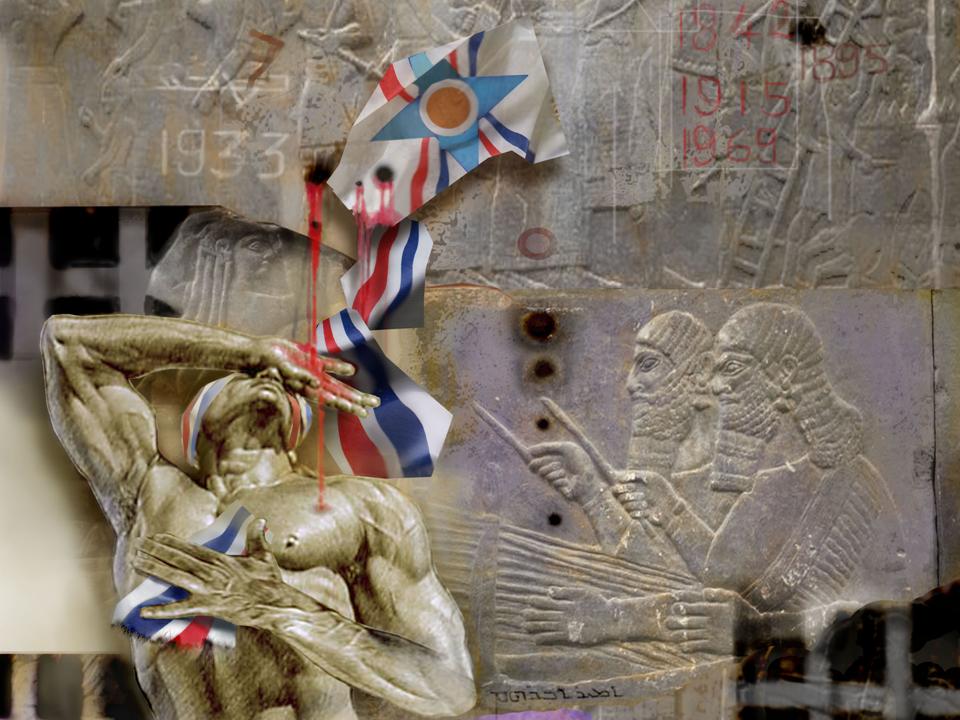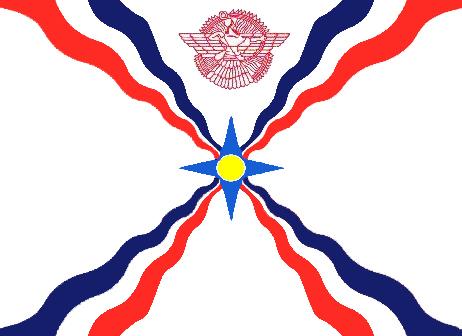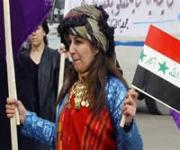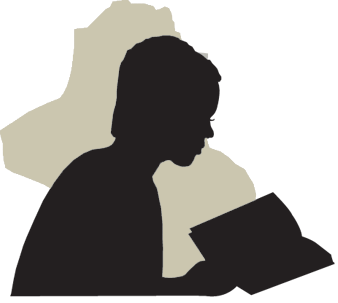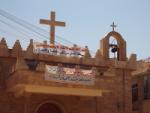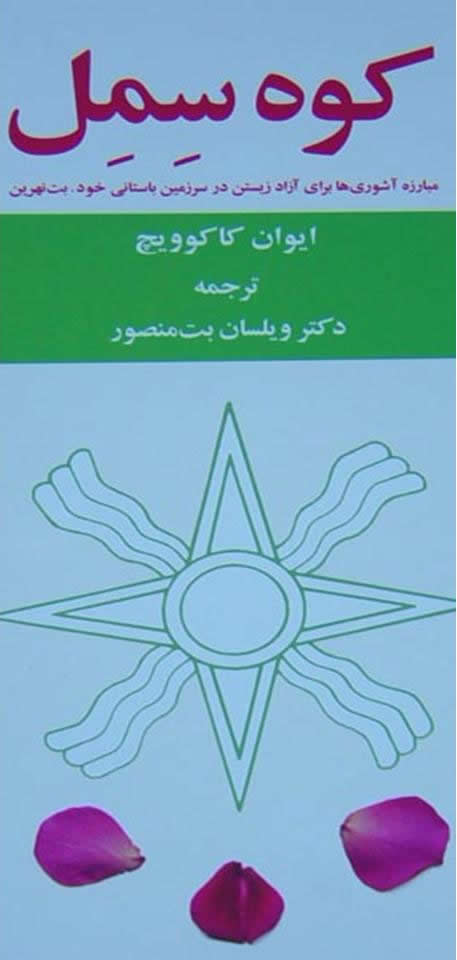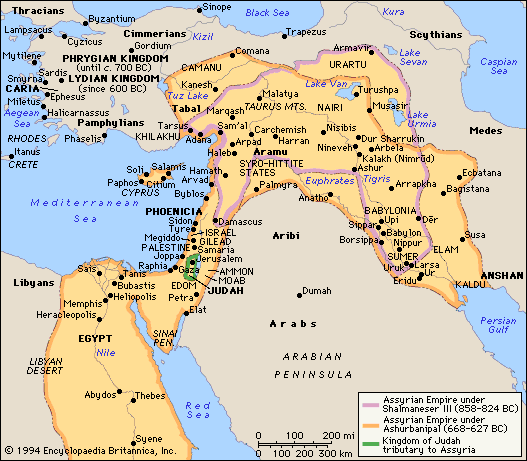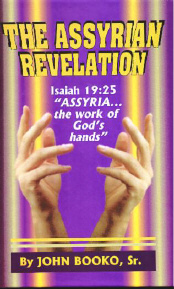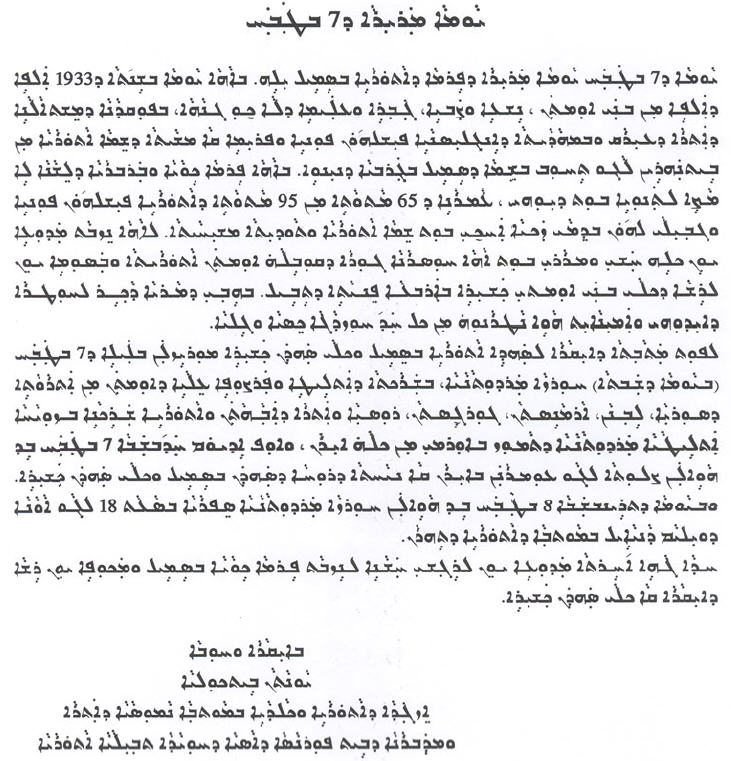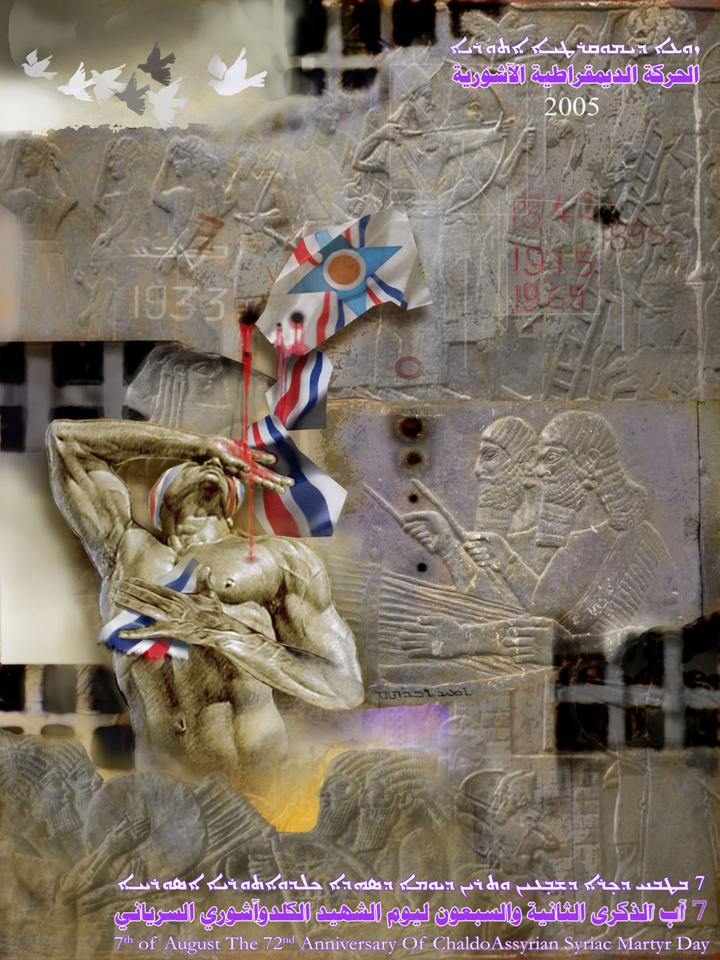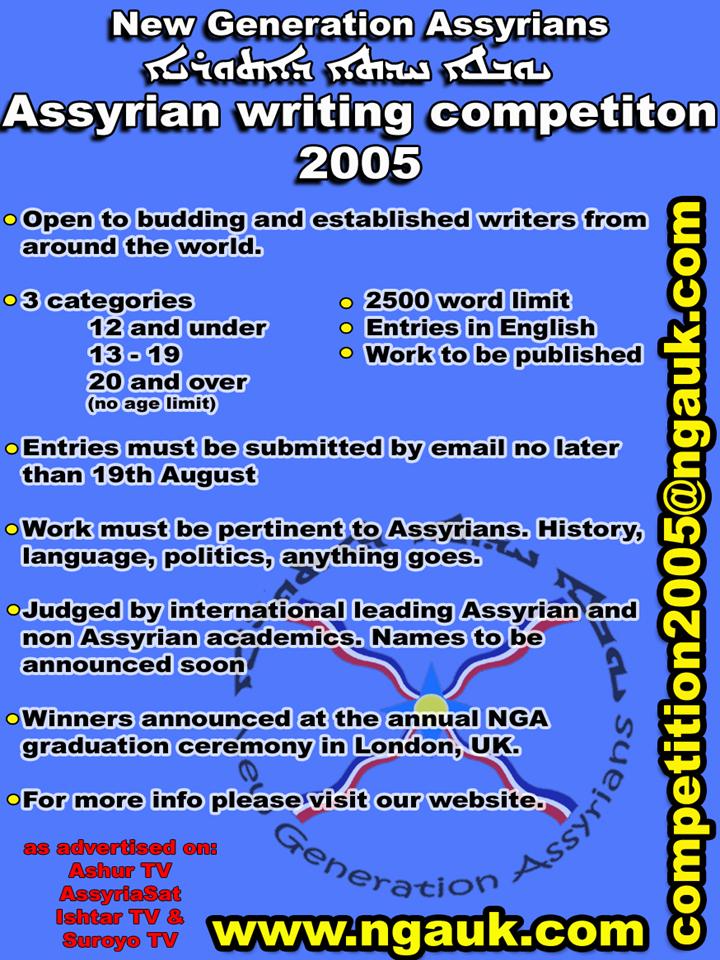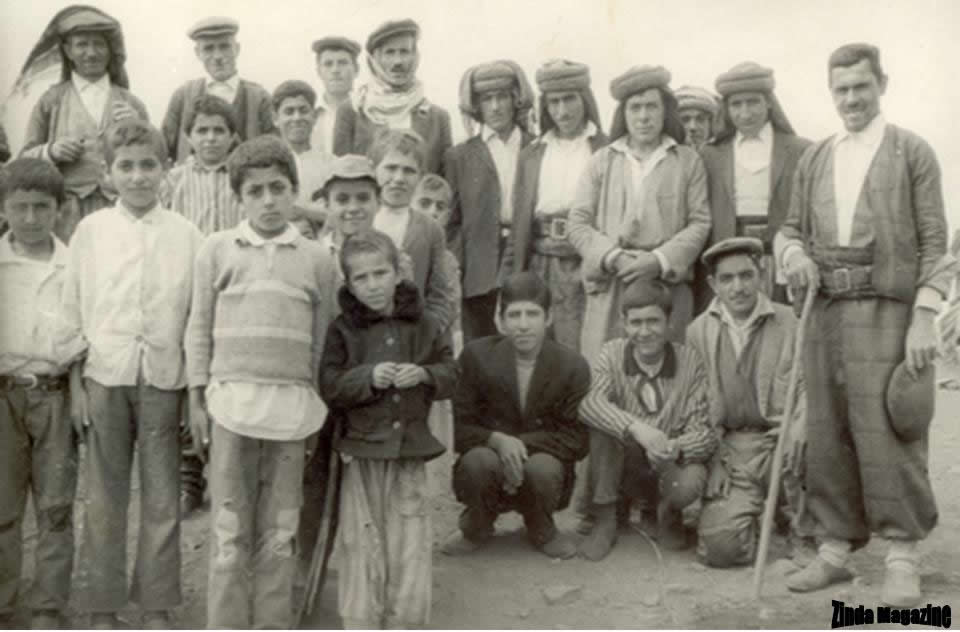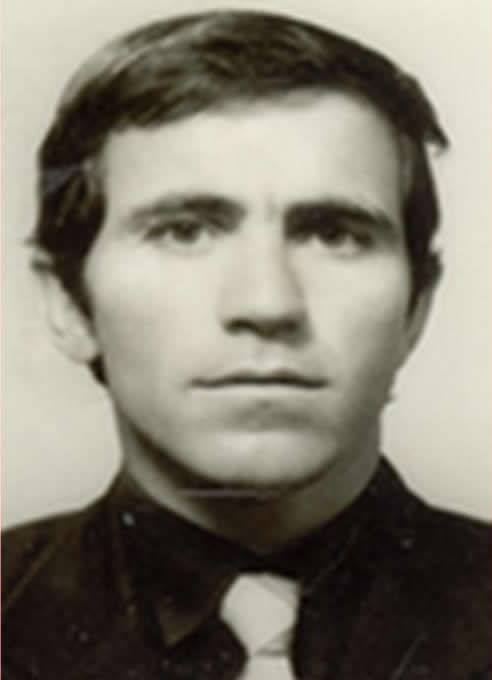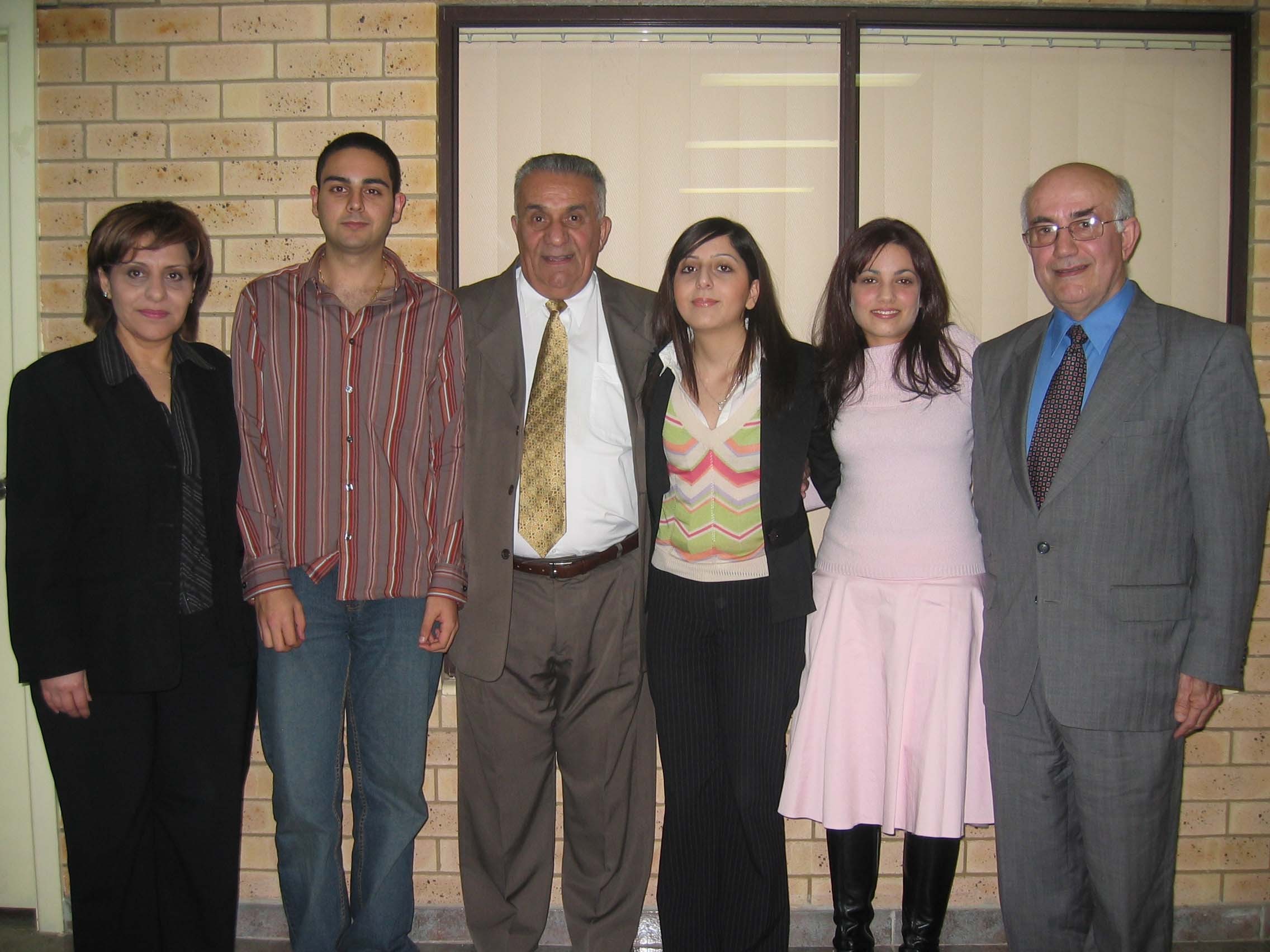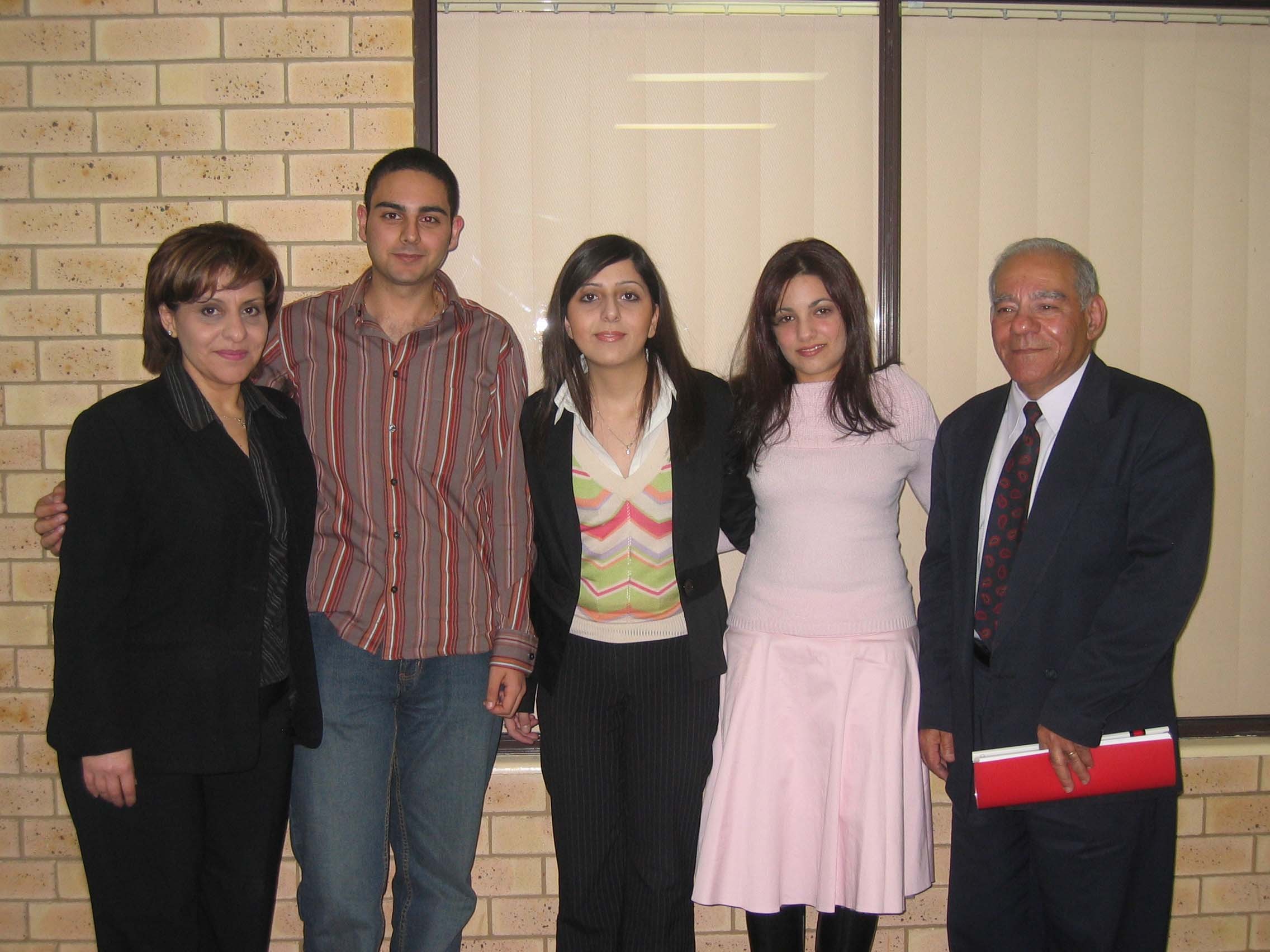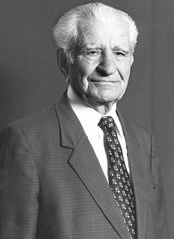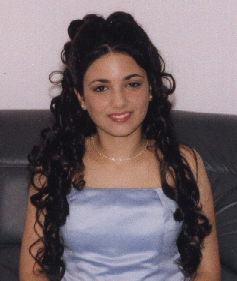Assyrian Assimilation
Matthew Matuszak
One Magazine / CNEWA
July 2005
Abraham Lazar, an Assyrian Christian, decided to leave Iraq with his wife and daughter after the 1991 Persian Gulf War. The state-sanctioned “pressure” on the Assyrian community was becoming unbearable, he said. “Year after year, things got worse. We couldn’t stay anymore.”
In 1994, the Lazars made it to Greece and from there pushed on to the United States, where Mr. Lazar found work as an assembly inspector at an electric company. Mr. Lazar’s parents joined him two years later. In 2000, his brother Jacob came on a student visa. In the past few years, each of Abraham’s five siblings has left Iraq for the West.
Abraham Lazar’s decision to settle in Chicago was no accident. For more than a century Assyrians have been coming to Chicago: First, in the 1880’s and 1890’s, as seminarians and medical students and later, most notably following World War I, as refugees fleeing persecution. Just as Lebanese immigrants joined their predecessors in Detroit and its surroundings, Assyrians flocked to Chicago. Today, about 80,000 Assyrians are estimated to live in the Chicago area.
Iraqi-Americans in Chicago celebrate the recent Iraqi elections. (photo: John Gress)
Photo Removed Due to Copyright Guidelines |
Like most Assyrians living in Chicago, the Lazars belong to the Assyrian Church of the East, an ancient faith community that traces its origins to Mesopotamia and St. Thomas the Apostle. Over time, the church expanded throughout to such faraway places as India and China, but its center, or catholicosate, remained in the heart of Mesopotamia, settling permanently in Baghdad after it became the capital in 780. During the invasions of the Mongols in the 14th century, this church was nearly destroyed. The formation of the Chaldean Church (a community of Assyrians who, while retaining the rites and traditions of the Church of the East, are in full communion with the Church of Rome) in the 16th century further weakened the Church of the East.
The 20th century was no kinder to the Assyrian Church of the East. During World War I, the Turks wiped out about one-third of the population, with most survivors fleeing to what is now modern Iraq. After the end of the British Mandate in 1933, Iraqi troops attacked the Assyrians and expelled its leader, Catholicos-Patriarch Mar Shimon XXIII, who settled in San Francisco. The catholicos’s adoption of the Gregorian (or Western) calendar and his commitment to the practice of hereditary succession triggered a dispute within the church that threatened to lead to a schism.
Mar Shimon, who was forced to resign but later resurfaced as catholicos-patriarch, was assassinated in 1975, prompting his successor, Mar Dinkha IV, to move to Chicago, which has become the home of the Assyrian patriarchal see. Much has been done to relieve the tensions within the church, which since the 1990’s has been engaged in dialogue with the Roman and Chaldean churches.
Today, the Church of the East has about 300,000 members worldwide, with more than one-third in the United States. About 80,000 of U.S. church members live in the Eastern half of the country, most of them in the Chicago area. About 5,000 church members live in California.
Every Sunday at Chicago’s St. George Assyrian Cathedral, priests and deacons chant the office that precedes the eucharistic liturgy, or Qurbana, while in a room behind the altar, Father Antwan Latchen bakes the bread used in the liturgy. Father Latchen, Mar Dinkha’s secretary, usually celebrates the Qurbana at another Assyrian parish later in the day.
“All churches up to the first or second century had the same practice,” said Father Shlemon Heseqial, dean of the cathedral. “We stick to the old way. We make the dough and eat the bread on the same day.”
Near Detroit, Iraqi-Americans join in traditional Assyrian dances. (photo: AP/Wide World Photos)
| Photo Removed Due to Copyright Guidelines |
According to Assyrian tradition, bread made for the Qurbana is derived from the bread that Christ shared with his disciples at the Last Supper. In the Church of the East, a portion of the dough, called the malka (Aramaic for “king”), is reserved and added to the bread for the Eucharist each time it is baked. Theologians of the Church of the East often refer to the malka as a “sacrament.”
“Special prayers are recited during the making of the bread,” Father Heseqial said.
Father Heseqial came to Chicago from Iraq with his wife, three daughters and son in 1990. He has no immediate family in Iraq, though he has friends and cousins with whom he has occasional contact.
Church volunteer Walten Mirza, another Iraqi immigrant to Chicago, also showed up early to help with preparations before the Sunday services. Mr. Mirza owns a manufacturing business in Northbrook, a Chicago suburb. He began volunteering at the cathedral six years ago. “I have three children in Sunday school and that is why I got involved,” he said. “I wanted to help get the next generation involved with the church.”
Mr. Mirza, 55, said he came to Chicago 33 years ago in search of a better life. “My oldest brother was in college in Chicago and there were lots of Assyrians here, so this is where I wanted to come.”
Through the church and other social clubs, he interacts with fellow Assyrians on a daily basis. Mr. Mirza also married a fellow Assyrian, Maryam. (Among recent immigrants the intermarriage rate is only 10 percent.)
To a remarkable degree, Assyrian Americans have held on to their culture and ancient Semitic language, Aramaic, a tongue related to Amharic, Arabic and Hebrew. Mr. Mirza speaks a modern version, Assyrian, also called Neo-Syriac, and his children learn it in classes held at St. George.
Liturgies are celebrated in Aramaic, the language of Jesus, though sermons and Bible readings are in Neo-Syriac. According to Mar Bawai Soro, the Assyrian Church of the East Bishop of Western California, some parishes have introduced the vernacular into their liturgies. (The Church of the East also has two English-language parishes, one in Seattle, one in Sacramento. These parishes, which originated from reformed ecclesial communities, were received into the Church of the East in 1968 and 1978 respectively.)
Father Latchen prepares the bread used for the Qurbana, or eucharistic liturgy. (photo: Christian Molidor, R.S.M)
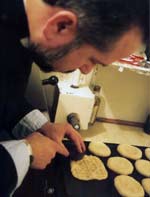 |
The primary eucharistic prayer of the Church of the East, the Anaphora of Addai and Mari, is the oldest anaphora of the church. It is also one of the earliest of all eucharistic prayers used in any church, Catholic or Orthodox. The prayer makes no explicit mention of the words of institution, which in the past were considered necessary by the Catholic Church for the transformation of the bread and wine into the body and blood of Christ. Three Vatican departments have recently confirmed the Anaphora of Addai and Mari as an authentic expression of the universal church’s eucharistic faith.
In the past, an even greater impediment to relations between the Church of the East and the Catholic and Orthodox churches was the unique Christology of the Church of the East. This understanding of the person and nature of Jesus Christ as expressed in the Assyrian tradition has also been re-evaluated and, for Catholics at least, is no longer considered unorthodox. In 1994, Pope John Paul II and Mar Dinkha IV signed the Common Christological Declaration, which effectively erased 1,500 years of misunderstanding. “Historically, our tradition was branded as heretical,” Mar Bawai said. “Dialogue with Rome has put our church on the ecclesiastical map once again.”
In general, the Church of the East’s rituals retain much of its Semitic connections. “The seat of Moses is preserved, now used by the bishop,” Mar Bawai said. “The eucharistic prayer is an augmentation of the Jewish thanksgiving prayer after meals.”
The primary eucharistic prayer of the Church of the East, the Anaphora of Addai and Mari, is the oldest anaphora of the church. It is also one of the earliest of all eucharistic prayers used in any church, Catholic or Orthodox. The prayer makes no explicit mention of the words of institution, which in the past were considered necessary by the Catholic Church for the transformation of the bread and wine into the body and blood of Christ. Three Vatican departments have recently confirmed the Anaphora of Addai and Mari as an authentic expression of the universal church’s eucharistic faith.
In the past, an even greater impediment to relations between the Church of the East and the Catholic and Orthodox churches was the unique Christology of the Church of the East. This understanding of the person and nature of Jesus Christ as expressed in the Assyrian tradition has also been re-evaluated and, for Catholics at least, is no longer considered unorthodox. In 1994, Pope John Paul II and Mar Dinkha IV signed the Common Christological Declaration, which effectively erased 1,500 years of misunderstanding. “Historically, our tradition was branded as heretical,” Mar Bawai said. “Dialogue with Rome has put our church on the ecclesiastical map once again.” |
Perhaps another link to the Assyrian Church of the East’s Semitic roots is the absence of icons or religious imagery in its churches. Mar Bawai traced this development to living in a predominantly Muslim society, where images of the sacred are prohibited. “But there are clear liturgical traces” calling for the use of images, he said. Mar Bawai believes that liturgical reforms are essential to keeping the Church of the East alive. “We have trouble evangelizing, because at most churches the liturgies are in Aramaic, and there are not many Americans who speak it or are willing to learn,” he said. “And we are losing young Assyrians, who have grown up in the United States, because of the language too.”
Many younger Assyrians join Catholic or Protestant churches, Mar Bawai said. Stronger ties with the Chaldean Church would strengthen the Church of the East, Mar Barwai added. Already, there is some cooperation, as is evinced by the two Chaldean parishes in Chicago.
“We cooperate,” Father Heseqial said. “For example, when somebody passes away, we go to that church. Frequently, there are marriages between Chaldeans and Assyrians, special dinners in which we invite them and they invite us.”
The hope was that after the war, Assyrian Americans would go back to Iraq or invest there, but that has been put on hold.
Though only 40,000 Assyrians live in Iraq, the vast majority of vocations to the priesthood and the diaconate come from the Middle East. “So the mentality of the Church of the East remains overwhelmingly Eastern,” Mar Bawai said.
A man kisses a cross before the liturgy begins at St. George Cathedral in Chicago. (photo: Christian Molidor, R.S.M)
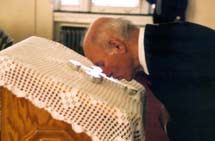 |
Assyrian seminarians receive their theological education at the Chaldean College in Baghdad. Assyrian bishops and priests who pursue graduate studies also benefit from CNEWA scholarships in Catholic universities throughout the world. There was talk of moving the catholicosate back to Iraq after the fall of Saddam Hussein’s regime, Mar Bawai said.
“In terms of the credibility of our church, I think it is essential to return to Iraq. But for now, while there is so much instability, that is not a possibility.” Just as the church hierarchy, based in Illinois, looks to the Assyrian homeland of Iraq, so too does the greater Assyrian community of Chicago.
Though he no longer has family in Iraq, Mr. Mirza closely follows events back home. “Generally, Assyrians were very happy to see the old regime of Saddam toppled,” he said. “There was a feeling of excitement, which has given way to uncertainty with all the terrorist attacks, including attacks on Assyrian churches in Baghdad.
“The hope was that after the war, Assyrian Americans would either go back to Iraq or invest there, but that has been put on hold for now,” Mr. Mirza said.
Until some sort of stability returns to Iraq – allowing for return visits, investments and, in some cases, emigration – the Assyrians of Chicago will continue to hold on to their Mesopotamia-born traditions by looking inward. For Mr. Mirza, his work at St. George Assyrian Cathedral allows him to stay rooted in both the religious and cultural life of his ancestors. On Sundays, his day at the cathedral usually begins at 7:30 a.m. and ends at 3 p.m.
“Believe me, it’s a lot of work,” he said, adding that he did not mind it one bit.
 Matthew Matuszak is director of the Religious Information Service of Ukraine. Matthew Matuszak is director of the Religious Information Service of Ukraine.
The Syro-Malankara Catholic Church
Michael J.L. La Civita
One Magazine / CNEWA
July 2005
For one day, a modest man in the teaming city of Trivandrum, capital of the southern Indian state of Kerala, was the center of much attention.
On 14 May 2005, dignitaries from around the world, led by the Prefect of the Congregation for the Eastern Churches, Patriarch Ignace Moussa Cardinal Daoud, converged on St. Mary Cathedral. There they celebrated the elevation of the Syro-Malankara Catholic Church to the dignity of a major archiepiscopal church, a status that accords it more autonomy within the Catholic communion of churches. But they focused their energies on its self-effacing leader, Major Archbishop Cyril Mar Baselios.
The archbishop, who celebrated the 25th anniversary of his episcopacy last year by building houses for the poor, is just the third leader of the Syro-Malankara Catholic Church. A noted scholar, ecumenist and pastor, Mar (a Syriac honorific for “Lord”) Baselios follows in the footsteps of two giants of the 20th-century universal church: Benedict Mar Gregorios, a gregarious man who guided the Syro-Malankara community from 1953 until his death in 1995; and Mar Ivanios, a visionary whose quest to reunify Kerala’s Christians led, in 1930, to the establishment of the Syro-Malankara Catholic Church.
Though the youngest of the 21 Eastern Catholic churches, the roots of this community stretch through nearly two millennia of Indian history and culture.
Apostolic origins. Until Portuguese explorers, merchants and fortune hunters arrived in southern India in the late 15th century, Kerala’s Christians flourished as a unified church. These “Thomas” Christians traced their faith to the evangelizing efforts of St. Thomas the Apostle, who is thought to have arrived on the shores of Kerala in the year 52, subsequently establishing seven faith communities.
Isolated from the development of the church west of Jerusalem – as well as the schismsand controversies that destroyed its unity – the heirs of St. Thomas were in communion with the Assyrian Church of the East, sharing its distinct Eastern Syrian liturgy and traditions. First developed by Mesopotamia’s Jewish-Christian community, who had also received the Gospel from Thomas, these customs were enhanced by Syriac-language scholars working independently of the churches of Rome and Byzantium.
Ties between Assyrian and Thomas Christians were strengthened by trade, the periodic immigration of Assyrian Christians to southern India and regular visits of Assyrian bishops to the subcontinent to ordain priests and deacons. In the eighth century the Assyrian catholicos-patriarch appointed a hierarch with the title of “Metropolitan and Gate of All India” to shepherd the Thomas Christians, though authority resided with an “Archdeacon of All India,” an Indian priest appointed by the metropolitan. Though not without its own internal conflicts, the Thomas Christian community was thoroughly integrated into the fabric of southern Indian society but remained Eastern Syrian in its religious heritage.
Encountering Europe and polarization. Southern India’s Thomas Christians welcomed the Portuguese explorers as companions in the faith, reaffirming their fidelity to the successors of St. Peter, the bishops of Rome, while retaining full communion with the Assyrian Church of the East. Such dual loyalties, however, were not possible in an ascendant Europe eager to dominate the world’s stage. Europe’s age of exploration coincided with the Protestant Reformation, the Catholic response and its subsequent Inquisition, the rise of the European nation-state and the European quest for empire.
|
Assyria: Its History & Future
by Frederick Aprim |
Tuesday, 9 August 2005
4:45 p.m., Reception | 5:15 p.m., Program |
Club office, 595 Market St., 2nd floor, San Francisco
$8 for Members, $15 for Non-members
Click to Register | Directions |
|
Thomas’s heirs were unaware of these movements. They did not understand that, in a rapidly shrinking new world, fidelity to Peter and his heirs – despite the exhortations of the popes to the contrary – meant absolute conformity. As the Portuguese subdued the indigenous secular authority, so too did they subdue the authority of the local church. They “regularized” the ecclesial life of the Thomas Christians, creating Roman (or Latin) dioceses, replacing the Assyrian eucharistic liturgy (or Qurbana) with the Roman rite when opportune, or purged elements from the Qurbana assessed as heretical.
In 1599, Portuguese Archbishop Alexis de Menezes of Goa called a synod that, while not outright suppressing the Qurbana, imposed European bishops of the Roman rite as well as Roman doctrine, law, rubrics and disciplines, such as clerical celibacy.
The decrees of this Synod of Diamper polarized the Thomas Christian community and culminated with the historic Coonan Cross Oath in January 1653, when most Thomas Christians severed their ties to the Church of Rome and re-established the pre-Portuguese order.
Syrian ties renewed and further division. Through the pastoral diplomacy of the Carmelite friars, the papacy re-established full communion with the vast majority of Thomas Christians (the nucleus of the modern Syro-Malabar Catholic Church). A significant number, however, remained firm in their resolve for independence. Attempts to contact the Assyrian Church of the East (which had its own internal crises) failed. By 1665 those Thomas Christians separated from the Church of Rome had pledged fidelity to the Syrian Orthodox Patriarch of Antioch, in theory accepting the Christology and liturgical traditions (defined as Western Syrian) of the Syrian Orthodox Church. It took more than 200 years, however, for this “Malankara” church to become truly Western Syrian, as its Assyrian roots were firmly entrenched in the ethos of the community.
This Malankara Syrian Orthodox community, which formed an autonomous part of the Syrian Orthodox Church, suffered internal strife and, eventually, additional schisms. There were at least four unsuccessful attempts to re-establish full communion with the Church of Rome, while overtures to the Church of England resulted in the creation of a separate reformed church in the Western Syriantradition, the Mar Thoma Church. Additional internal battles over authority and autonomy led to the creation of a rival “Catholicosate of the East” in 1912, further fracturing the Thomas Christians.
Into this chaotic climate a giant of the 20th-century church – Gheevarghese (George) Panicker, better known as Mar Ivanios – was born.
Modern ecumenical advances. A scion of a prominent Malankara Syrian Orthodox family, the future archbishop, born in 1882, was singled out early as his community’s hope. He entered the seminary in Kottayam, received a graduate degree in economics in 1906 and later occupied the chair of Syriac, church history and political economy at Serampore University College, a Protestant institution in Calcutta.
Like his contemporaries, Rabindranath Tagore (1861-1941) and Mahatma Gandhi (1869-1948) – whose writings inspired the young priest – Father Gheevarghese was preoccupied with the renewal of his community. He envisioned a monastic community for men and women that would integrate the monasticism of his own Syriac tradition with the essence of Hindu spirituality, or sunyasi, the process of leading an interior life. Deeply spiritual, he reasoned that a community dedicated to contemplation, social action and evangelization would spark renewal.
Eventually, Father Gheevarghese resigned his teaching post and returned to Kerala, founding the Bethany ashram (Sanskrit for a religious sanctuary) modeled on the Gospel account of Bethany. In an interview with this magazine in February 1998, one of the last surviving original members of the ashram, 94-year-old Father Raphael, described a “revolutionary” spirit at the monastery, which combined the asceticism of the Hindu monk with the social teachings of the church and a commitment to imitate Christ.
“Having taken the three vows of chastity, poverty and obedience,” he recalled, “we Christian sunyami [monks]… led a simple, spiritual life. All were vegetarian, slept on the floor, ate from simple earthen pots, had only two sets of clothes, observed virtual silence and were at prayer five times a day.” On Sundays, the monks went into the community, preaching, counseling and consoling.
The Bethany ashram stirred interest among the Malankara Syrian Orthodox faithful, who, according to observers, continuously sought the community’s counsel. As Bethany grew, so too did interest among the Thomas Christians in a “reunion movement,” which picked up steam particularly after Father Gheevarghese was consecrated bishop in May 1925. Choosing the name Ivanios, the new bishop immediately challenged the catholicos, bishops, priests and people of the Malankara Syrian Orthodox Church to “bring all the Syrian Christians of Kerala, who formed one church formerly, into true union once again so that the biblical idea of ‘one fold and one pastor’ may become a reality.”
Charged by the synod of the church, Mar Ivanios contacted the Holy See in 1926 about re-establishing full communion between the two churches, provided the Holy See recognize the validity of Malankara Syrian Orthodox orders, preserve its eparchial (diocesan) structures in India and the use of the Western Syrian liturgy.
Modern developments. In September 1930, Mar Ivanios, his brother bishop of Tiruvalla, Mar Theophilos, two Bethany monks and a layman entered into full communion with the Church of Rome. Eventually, the entire community of Bethany sisters (founded in 1925) affirmed their communion, but all became homeless as the properties of Bethany were retained by the Malankara Syrian Orthodox Church.
Two years later, Pope Pius XI appointed Mar Ivanios as Metropolitan Archbishop of Trivandrum, with Mar Theophilos as suffragan bishop of Tiruvalla, thus establishing the youngest of the Eastern Catholic churches – the Syro-Malankara. This prompted a significant movement of the faithful into the new church, which, at the death of Mar Ivanios in 1953, numbered more than 66,000 people.
Under the leadership of Benedict Mar Gregorios, the church grew even more rapidly. A renaissance man, Mar Gregorios spoke Malayalam and Tamil, the vernacular languages of his church community, as well as English, French, Italian, Latin, Portuguese and Syriac, the liturgical language of his church. He corresponded with academic societies throughout the world, collecting the latest research on plant life, agricultural techniques and the breeding of livestock and chickens.
Why would an archbishop run a farming cooperative?
“First we must go among our people, feed the poor, heal the sick, wipe away the tears of despair,” the archbishop said the year before his death in 1995, “and then preach the Kingdom of God.”
Today, some 405,000 people, most of them living in five eparchies in South India, belong to the church. A considerable number have also emigrated to other Indian states as well as North America and Europe.
In Kerala, the Syro-Malankara Catholic Church is particularly active in education and health care. In addition to Mar Ivanios College in Trivandrum, the church runs an additional six colleges and 270 schools as well as 13 hospitals. The Bethany community’s Health for One Million program – founded by Mar Gregorios’s auxiliary, Mar Ephraem – takes health care to the masses, regardless of caste or creed, providing primary health care services to the poorest of the poor.
The dream of Mar Ivanios, to unite the Thomas Christian family, has not been abandoned. The St. Ephrem Ecumenical Research Institute in Kottayam draws Catholic, Orthodox and Protestant scholars from around the world to study the common heritage of the Thomas Christian community.
Nurtured by Major Archbishop Cyril Mar Baselios (whose outreach touches Roman and Syro-Malabar Catholics as well as the large numbers of Thomas Christians belonging to other jurisdictions), the Syro-Malankara Catholic Church continues to follow Christ in an Indian way, addressing the community’s problems and seeking solutions while pointing out the necessity of unity.
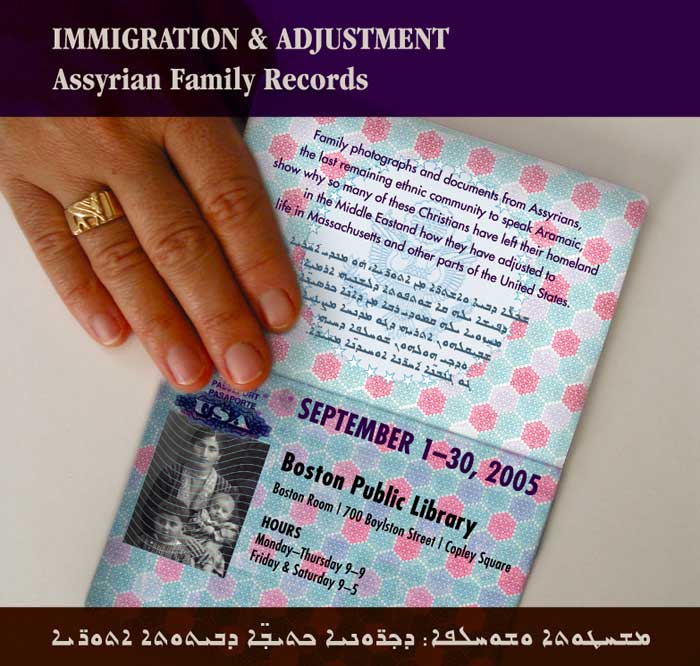
|

